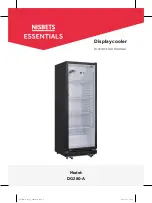
Part No. 26120 Rev. G August 2018
- 16 -
Inline 4000 Series Cabinets
Interior
cont.
REFRIGERATED CABINETS
-
CLEANING
Cleaning the
Base Cavity
Sweep out, or use a vacuum cleaner, to remove any debris from the cabinet
base cavity.
Make sure that the condensate drain hole is clean.
A Wet-and-Dry vacuum cleaner should be used, since there is likely to be some
water in the bottom. Finally, wipe out the bottom with a damp sanitized cloth.
Do not pour water into the base, or the condensate container will
overflow.
Cooling Fins
If there is food stuck in the cooling fins, it is best
to use a wet and dry vacuum cleaner to suck out
the food. DO NOT attempt to hose food parts
from fins.
Caution:
The fins are very sharp. Take extra
care when cleaning this area. Do not bend the
fins over, as this would restrict the air flow and
degrade cabinet performance.
Temperature
Probes
Take care not to damage or move the temperature probes, when cleaning the
cooling fins.
One probe is located on the fan side of the cooling coil, in free air. A second
probe is inserted between the fins of the cooling coil on the air exit side.
Do NOT move the probes.
Condensate
Container
The condensate container is only designed to handle cooling-coil defrosting
liquid that drains from the well.
DO NOT fill the well with liquid, or attempt to hose out as condensate
container will overflow and leak onto floor.
Trays, Shelves
& Air Grills
Stainless steel trays, shelves, grills etc. should be cleaned with hot soapy water.
Do not use abrasive pads or cleaners (e.g. Scotchbrite pads or Jif), as these
may damage surfaces.
Warning:
Dishwasher detergents will damage any anodised aluminium parts.
Re-assembly
Take care to re-assemble panels and covers correctly, as any air gaps can
adversely affect air circulation and the cabinet temperature.









































